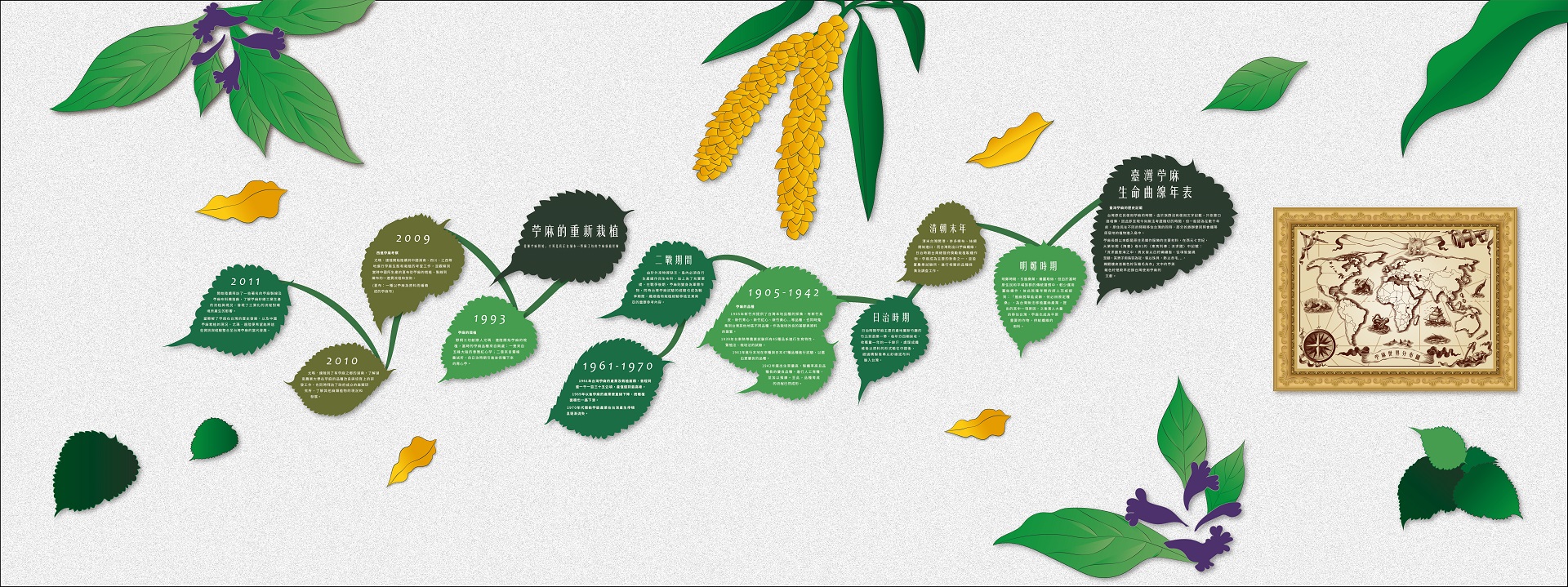date of issue:2021-02-26

Historical Records of Ramie in Taiwan
During much of Taiwan’s history, none of Taiwan’s indigenous tribes had a written language. They relied on oral tradition to pass on their histories. Therefore, precise dates regarding the development and culture of ramie planting and weaving are not known. That said, it appears that well over 1000 years ago different indigenous groups arrived in Taiwan at different times, and some of them brought the plants from their former homes.
Indigenous people, especially those who lived in mountainous areas, used ramie fiber as material for fabric to make clothing. A section of 7th-century literature from the Sui Dynasty, Book of Sui, chapter 81, states: “Liu-qiu (a reference to Taiwan) is in the middle of the sea…men and women there use white zhu(a reference to ramie) to tie their hair, from the back wrapping around to the forehead…they wear leather, multicolored zhu, and assorted feathers as clothes.” This is one of the earliest literary records of the use of ramie in Taiwan.
The Ming-Zheng Era
During the Tungning Era, 1662-1683, mulberry leaves and seeds were brought to Taiwan, which allowed for the cultivation of silkworms and silk fiber. However, neither the indigenous peoples of the mountains, nor the recent immigrants of the plains and valleys, were eager to take upsilk weaving. In the middle of the Qing Dynasty, during the Qianlong era (1711-1799), the poet Fan Xian would write: “Pengma(a reference to ramie, or other types of flax) can be used to make brocades, so why waste land to grow mulberry trees? ”The silk production industry failed to develop. Ramie maintained its status in the mountains. Later, as Han Chinese immigrants poured into the island, ramie became an important resource in the flatlands as well.
Late Qing Era
In the late Qing Dynasty period in the 1800s, Taiwan opened its ports and began importing large quantities of cotton and silk fabric, while at the same time exporting ramie fibers. Later, the Japanese rulers of Taiwan would encourage development of certain areas of agriculture, including fiber-producing plants like ramie. An agricultural research institute was established, and ramie became a focus of investigation.
The Japanese Colonial Era
During this era, the center of Taiwan’s ramie production was an area stretching from Zhubei (Hsinchu County) to Miaoli County. This area produced four harvests per year, and the annual harvest total eventually rose to about 1000 kilograms. After being converted to fibers the ramie was shipped to China, where it was processed into yarn and fabric and sent back to Taiwan.
Ramie Breeding
1905 – Hsinchu researchers produced a collection of strains including “Hsinchu Black”, “Hsinchu Green”, “Hsinchu Red”, and “Hsinchu Yellow”. They studied other strains from around Taiwan, and laid the foundation for improved cultivation of ramie.
1939 – The Tropical Agriculture Research Center in Taitung studied and classified 45 strains of ramie, and conducted research on breeding for specific characteristics.
1941 – Further research was conducted, including assessments of 47 strains from Japan, toward the goal of selecting the highest-quality strains.
1942 – The chosen strains were those that were longer, with high quantity of stalks, and high fiber production ratio. Artificial breeding was done, and the plan was publicly promoted.
The Second World War
During the war, due to the scarcity of imports, Japanese-ruled Taiwan was once again forced to produce most of its own fabric. Toward the end of the war, ramie was an essential resource for the military effort, and production of ramie was a priority. The Japanese military oversaw ramie production and processing in Taiwan, and Taiwanese expertise in planting, breeding, and cultivating ramie spread outward all over Southeast Asia.
1961 – Ramie production area in Taiwan reaches 1135 hectares, with the total value of ramie production reaching its peak.
1969 – Ramie production sharply drops.
1970 – Ramie production reaches a standstill, then thereafter begins to gradually disappear.
The Renewal of Ramie
To do real weaving, one must start with seeds – planting ramie at Lihang Studio (Yuma Taru’s workshop)
Ramie Planting
Yuma Taru began planting ramie in 1993. At that time, ramie strains came from two places: the first was from Hsinchu County, Wufeng township, Dayi Community, Atayal Red Strain; the second was from Taiwan Agricultural Research Institute, Taichung City, Green Strain.
Ramie From the West
2009 – Yuma Taru went to China (Hunan, Sichuan, Jiangxi) to research ramie planting and ecology. She was captivated by the full process of how “xiabu” fabric was produced, from planting to yarn to processing.(“Xiabu” is a particular type of fabric produced by ramie weaving)
2010 – Yuma Taru arrived in the ramie hotspot Hunan and visited Hunan Agricultural University, where she studied the breeding and improvement program. She also visited the Flax Research Center in Hunan, and studied types of flax/hemp other than ramie.
2011 – Yuma Taru visited a number of well-known ramie yarn and ramie fabric weaving factories, and gained an understanding of the industrial yarn-making process, and the effects this process has on the environment.
Having become an expert in the history and development of Taiwanese ramie culture, and having observed the innovations and impacts of the ramie industry in China, Yuma Taru strives to use her experience and knowledge to update and develop useful and fascinating element of Taiwanese culture.
